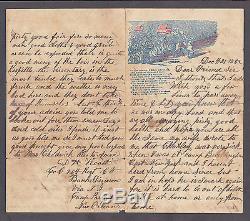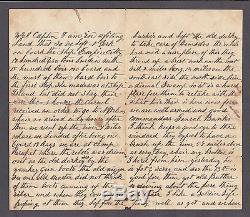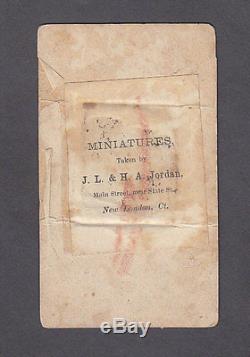Civil War Soldier Letter Daniel R, Roath 26th CT IIllus + Tintype Dec 21, 1862





Outstanding Civil War soldier letter and image of Daniel R. Went up river and landed after being on board for 19 days, we are at Camp Parapet where the rebels were driven out, as the old darkey says by the Yankee gunboats, the old negro is our old master, they (the rebels) did not think of the boats coming up the river and when they (the boats) fired on them they ran for the bushes, and left the old darkey (s) to take care of themselves, the rebels had made a nice place, through up a breastwork, 2 miles long hear a dismal swamp, hard for them (the rebels) to retake, we are well armed and good commanders, General Banks, also mentions old Butler, likes soldiers life pretty well, have good clothes and good grub, many men in the hospital with dysentery, they eat too much fruit and the water is very bad and they don't take care of themselves. More content, Roath writes phonetically and has some trouble with grammar at times. The image of Roath is a great miniature tintype mounted within a fancy frame on card. The card does have some condition issues.
Do not think his name on the card is in his hand, undoubtedly done later by a family member, the image was taken at J. Jordan in New London CT. The ID is most surely correct as the letter and image came from the family. Roat h enlisted August 22, 1862 and left sick on August 5, 1863 just about a year later. This is a superb combination of Civil War items, the letter with great content, the illustrated color lettersheet, and his image.
The letter has some minor archival repairs and probably could use a bit more reinforcing in places. The letter is a bit fragile but overall solid. CT; Enlisted on 8/22/1862 as a Private. On 11/10/1862 he mustered into "C" Co.(date and method of discharge not given) He was listed as: Left sick 8/5/1863 Toledo, OH (No further record) Sources used by Historical Data Systems, Inc. Connecticut: Record of Service of Men during War of Rebellion (c) Historical Data Systems, Inc. From Wikipedia, the free encyclopedia.
National Register of Historic Places. The Camp Parapet powder magazine in 2008. Camp Parapet was a Civil War.A bit more than a mile upriver from the current city limits of New Orleans. 1863 map of Camp Parapet.
The fortification consisted of a Confederate. Defensive line about a mile and 3/4 long stretching from the Mississippi River. The area further north from the ridge to Lake Pontchartrain.
Was at the time swampland. This was intended to protect the city of New Orleans from Union. Took the city by sailing in from below, the fortification was never used.
After the capture of New Orleans. Forces garrisoned and expanded the fortifications to defend against a Confederate. Under Union control, the Camp lay in the district of Brigadier General Thomas W. In late-September 1862, Halbert E.
Captain of the Fourth Wisconsin Volunteer Regiment. Assumed command of the camp. A lieutenant in the 12th Connecticut Infantry Regiment. Was detailed as Aide de Camp for Sherman for the superintendence of the many contraband. He organized six colonies at Camp Parapet each led by a non-commissioned officer and directed black labor in the repair and fortification of the camp and surroundings.
This scheme was expanded under Hanks to become the Bureau of Negro Labor, which was one of the organizations which would eventually become the Freedman's Bureau. The only remaining structure of the fortification is the powder magazine. Of brick enclosed in an earth mound. It is located off Causeway Boulevard near the American Legion Post 267, preserved in a small park and added to the National Register of Historic Places. Nearby is the historic Shrewsbury (Camp Parapet) Cemetery. The site of the camp's cemetery, where 7,000 Union bodies were once interred before being moved to Chalmette National Cemetery. WRITTEN BY CAPTAIN LOREN A. GALLUP, LATE OF COMPANY F, TWENTY- SIXTH CONNECTICUT VOLUNTEERS.THE Twenty-sixth Regiment was organized in September, 1862, under General Orders No. Recruiting occupied from about August 20th to September 10th, when ten companies assembled at Camp Russell, Norwich, coming from New London and Windham Counties. The officers of the line were elected by each company after its enlistment, before they were commissioned. On September 19th the field officers were elected by the line officers. The staff was appointed by the Governor.
On September 25th the regiment was formally mustered in by a United States mustering officer, but the rolls were not signed. From this time to November 13th the regiment remained in Camp Russell, and became quite proficient in company and regimental drill. On November 10th and 12th the regiment was again mustered in by United States Mustering Officer Lieutenant Watson Webb, who signed the rolls. Orders were received on November 12th to break camp, which was done on the 13th, and at 3 P.
The regiment, with full ranks, eagerly left its first camp and marched through the crowded streets of Norwich, viewed by thousands of spectators and friends, and embarked on the steamer "Commodore" for New York. On November 14th it was disembarked at Brooklyn, and marched to Centerville Race Course, where it made its second encampment until December 4th. This camp was known as Camp Buckingham.
On December 4th this camp was evacuated, and at 4.30 P. The regiment arrived in Brooklyn, and the same evening embarked on the steamer Empire City. Remaining in New York Harbor until the morning of December 6th, the steamer put to sea under sealed orders. It was not divulged until several days later that this regiment was a part of an expedition to rendezvous at New Orleans, under Major-General N. On the 18th disembarkation was made at Carrollton, a few miles above New Orleans, and tents were again pitched, at Camp Parapet, a large enclosure from the Mississippi to Lake Pontchartrain.Here for the first time arms were issued to the regiment, and officers and men eagerly studied and practiced the manual of arms. In common with all Northern men going into camp so far south, much malarial sickness appeared, and soon the hospital was more than full, and many died. The influence upon the men of these frequent and sudden deaths was somewhat dispiriting. On January 21 and 22, 1863, the regiment was paid off in full.
On or about March 13th, when Commodore Farragut passed up the Mississippi with his magnificent fleet and successfully passed the Port Hudson batteries, the cannonading of which could be distinctly heard in the regimental camp, it became quite evident that the Twenty-sixth was soon to participate in more active warfare at the front. For this change the men were impatient. On May 20th the regiment embarked at Carrollton, on board the steamer "Crescent, " for Baton Rouge, where it arrived on the morning of May 22d, and during the forenoon it disembarked some six miles above, at Springfield Landing, in full view of the river works of Port Hudson, which, like Vicksburg, was a high bluff at a bend in the Mississippi, and strongly fortified on the river front; also with a parapet several miles in length in the rear, passing over and across ravines, gulches, and woodland, enclosing a rebel camp of many acres, and garrisoned by 6,000 to 7,000 men under Major-General Frank Gardner. The Twenty-sixth regiment was at this time attached to the First Brigade (General Neal Dow), Second Division General T.Sherman, Nineteenth Army Corps Major- General N. Upon disembarkation at Springfield Landing the regiment was ordered immediately to the front to report to division headquarters. "Grim-visaged war" was now apparent. The mortar fleet below Port Hudson kept up a continual shelling of the rebel works, the missiles passing directly over the regiment. On May 24th the regiment joined the left wing of the corps investing Port Hudson, which had progressed from right to left.
The enemy were driven into their inner works during the afternoon of this day, abandoning their rifle-pits and outer works, ten in number, in front of Sherman's Division. During the evening communication was ordered to be established at the extreme front, between Sherman's and Augur's divisions on our right.
A detachment from the Twenty-sixth was selected for this purpose, and by 10 o'clock its object was accomplished, and Port Hudson was completely invested. May 25th, 26th, and 27th were days of preparation for the first assault by the entire corps upon the enemy's works, which were as strong as skill and time could construct. The bugle called into line Sherman's Division, but not until 1.30 P.
Was all in readiness for the charge. The Twenty-sixth occupied the right center of Dow's Brigade, and it so happened that at this point, by the "Slaughter" plantation house, were assembled Generals Dow, Sherman, and Andrews (Chief of Staff to General Banks), when General Dow ordered his brigade to the charge. With great enthusiasm General Sherman also in person ordered Forward! And led the column until he lost his leg and his horse by a shot. Charging over an open field upon a protected enemy is a story that has been told and written in the blood of thousands.
Impetuosity, bravery, and skill accomplished the same here and no more than at Fredericksburg and many other historic fields. An advanced position was secured and held. When the Twenty- sixth called its rolls after the battle, 107 were dead and wounded.Among the number were all ranks, from colonel to private. This regiment had received its first baptism of fire and blood, but only to prepare it for better service. The picket line that night was held in front of Dow's Brigade by the Twenty-sixth. From May 27th until June 14th the entire command was under continual fire, night and day. On the afternoon of June 13th a heavy skirmish line was thrown out on Sherman's front, in which the Twenty-sixth performed a conspicuous part, losing one man killed and seven wounded.
On June 14th a second general assault was ordered. Sherman, who had lost a leg May 27th, had been succeeded by General Dwight, who selected a position more to the left, and on the extreme right of the enemy, near the Mississippi River. The result of this assault was similar to the first. It was made in the early morning. No troops could have been better handled, or acted with more gallantry. In this charge the Twenty-sixth numbered 235 men, and its total casualties were sixty-one. Of this number four were killed and sixteen wounded by a single shell. After this battle the brigade commander said in his report: The nine months troops have demonstrated by their gallant conduct that they can be relied upon in any emergency. From June 16th to July 8th the siege was continued. On July 7th news was received of the surrender of Vicksburg, and on the next day Port Hudson surrendered, with 6,408 prisoners.General Banks's total casualties during the siege were 500 killed, 2,500 wounded (official). That the Twenty-sixth had borne a conspicuous part was acknowledged by its being selected as one of ten regiments to receive the capitulation of the garrison on July 9th, and was assigned to the left of the line- the second post of honor. From July 10th to 25th this regiment performed provost and guard duty at Port Hudson. On July 25th orders were received to break camp and embark on the steamer St. Maurice, and return to Connecticut for muster out, by reason of expiration of term of service.
The regiment left Port Hudson on the 26th, via Mississippi River, Cairo, Chicago, and New York; thence by steamer to Norwich, where it arrived August 7th. Upon its arrival it was received by the Mayor and city authorities, who bestowed upon the organization every attention and honor.
The Mayor delivered an address of congratulation and welcome, and the citizens turned out en masse and provided a sumptuous collation on the public park. On August 19th the regiment again reassembled in its original Camp Russell, and was mustered out and paid off. Kingsley, Twenty-sixth Connecticut Infantry, of the first assault. CONVALESCENT HOSPITAL, Baton Rouge, La. June 3, 1863 SIR: I have the honor to make to you the following report of the killed, wounded, and missing of the Twenty-sixth Regt. Part I, Reports & Union Correspondence. Volunteers, at the battle near Port Hudson, on Wednesday the 27th day of May, 1863: The regiment is in Gen. Dow's brigade and in the Second Division, commanded by Gen. We were ordered to make an assault upon the works, and to do it in four lines.The first line was formed by the Sixth Michigan, second, Fifteenth New Hampshire; third, Twenty-sixth Connecticut; fourth, One hundred and twenty-eighth New York. In advancing in line of battle, we encountered three high parallel fences, and, in getting over them, much confusion ensued, and before we could get into line the enemy opened on us with shell, shot, grape, and canister, mowing our men down by scores. As our men advanced, the ranks were thinned until after one hour's fighting, our men were compelled to seek shelter behind stumps, logs, &c. S Sherman and Dow were both wounded and carried from the field. The Twenty-sixth brought off the wounded and did not leave the field until past 8 p.
This is the first time the regiment has been under the enemy's fire and permit me to say that, with the exception of two or three, they did honor to themselves and credit to their State. I think the lieutenant-colonel may make a report also. Joseph Selden, Twenty-sixth Connecticut Infantry, of the first assault. IN THE FIELD, NEAR PORT HUDSON, May 31, 1863. I inclose a list of killed, wounded, and missing in this regiment, resulting from our participation in the attack on Port Hudson, on the afternoon of May 27, 1863. The attempt was made to take the rebel batteries and intrenchments by storm. Our regiment was formed in line of battle with the Sixth Michigan and One hundred and twenty-eighth New York Regiments in front of us, and the Fifteenth New Hampshire in our rear. The brigade was ordered forward on the double-quick.Four fences intervened between us and the intrenchments, which greatly impeded our advance. In passing these fences, the different regiments were thrown into confusion and became somewhat mixed up. On entering the field, a perfect shower of grape shot, and canister met us severely wounded Gen. S Sherman and Dow, and cutting down officers and men by scores.
Still, we advanced, and for more than two hours held the ground, and when obliged to fall back, it was not in disorder. I rallied our men, and formed the regiment near the entrance of the field, and we held the ground occupied by our brigade during the day. This being the first time the regiment had been under fire, I must be permitted to say that they conducted themselves with great gallantry and bravery, for the truth of which assertion I have but to point to the record inclosed.
Very respectfully, your most obedient servant, JOSEPH SELDEN, Lieut. Source: Official Records PAGE 123-41 W. For all Civil War and paper items. It depends on to what country. The following link will show all our listings.
Bookmark it so you can easily come back to our listings at any time. We are a member of the Manuscript Society, the Confederate Stamp Alliance, and life member of the American Philatelic Society.
The item "Civil War Soldier Letter Daniel R, Roath 26th CT IIllus + Tintype Dec 21, 1862" is in sale since Thursday, July 28, 2016. This item is in the category "Collectibles\Militaria\Civil War (1861-65)\Original Period Items\Correspondence, Mail". The seller is "antebellumcovers" and is located in Gaithersburg, Maryland. This item can be shipped to North, South, or Latin America, to all countries in Europe, to all countries in continental Asia, to Australia, ZA, to New Zealand.
- Daniel Roath Pvt soldier: civil war letter
- civil war soldier letter: Ship Empire City
- Camp Parapet: soldier ID'd image
- soldier image: tintype of soldier
- miniature tintype: Illustrated Lettersheet
- 26th Connecticut Infantry: negro during the civil war

